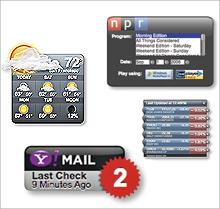Findability: $10 Billion Spent on Search Marketing in 2006
Labels: Advertising, brand building, Findability, Getting Found, Google, Internet, Media Trend Watching, ROI, search, Search Marketing, Yahoo Natural organic search is the most essential way to get found on the Internet. Websites not listed on the first page of Google keyword search results always generate sub-optimal traffic. Get found on that first page...and your desired brand advocates will respond.
Natural organic search is the most essential way to get found on the Internet. Websites not listed on the first page of Google keyword search results always generate sub-optimal traffic. Get found on that first page...and your desired brand advocates will respond.
Of course, getting to #1 is most desirable.
More and more, the corporate world seems to be understanding the importance of search marketing. That's a good media trend to watch, as these investments are already beginning to deliver strong ROI results.
According to an annual survey conducted by the Search Engine Marketing Professional Organization (SEMPO) relased last month, advertisers in North America laid out close to 10 billion dollars on search engine marketing in 2006 -- a 62 percent spending increase versus 2005. SEMPO found that based on its survey of 587 search agencies and advertisers, the amount of $$$ spent on search marketing will double by 2011, reaching $18.6 billion.
These figures include both paid search advertising and spending on internal search engine optimization.
The report says Google dominates the search advertising business. Among the marketers and agencies surveyed, 96 percent of them report using Google AdWords to promote their brands.
Yahoo! also does well, with 86 percent usage among search marketing budgets...
Meanwhile, less-used (and therefore less-cluttered) MSN, which has long struggled in a distant third-place position in the search race, has made great strides among advertisers, with 68% of advertisers saying they used MSN for their search campaigns in 2006, up from just 29 percent in 2005.
Key area for growth in search marketing: Brand Building
Search advertising for brand advertisers is still a less-than-mature growth category. Despite claims that more and more brands are using the Internet for branding, just 21% of search advertisers actually track or measure the branding impact of search for their campaigns.
Long Tail thoughts here
Brand Building: The Seven Doors of Connection here (pdf)
posted by Unknown @ Monday, March 05, 2007,
,
![]()
![]()
2007 Trend To Watch: Widgets
Labels: dashboard, gadgets, Google, Jointblog, Konfabulator, Media Trend Watching, New Media, widgets, Wireless, Yahoo Want to build your brand cross-platiform but having trouble getting it to happen online? Widgets just may be your answer.
Want to build your brand cross-platiform but having trouble getting it to happen online? Widgets just may be your answer.
And it's cost-effective, too.
The Jointblog has been a longtime fan of widgets since first discovering Konfabulator in 2004 (later purchased by Yahoo! a year ago). With the release of Window's new Vista platform, PC users will get a whole new array of widget options (also known as "gadgets") for the desktop which will pull more Internet activity off of web browsers and onto these customized mini-applications.
Widgets were one of several great additions for Mac's OS X system, epecially for its Dashboard advancements for 10.3 and 10.4 in the last year (expect even more once Leopard 10.5 and the new iPhone are released this summer).
And Google already has invested deeply into widgets, too. In addition, as WiFi and WiMax helps make the web more accessible with mobile devices and cellphones, widgets will be the key killer app to make the web tolerable to use when mobile.
In addition, as WiFi and WiMax helps make the web more accessible with mobile devices and cellphones, widgets will be the key killer app to make the web tolerable to use when mobile.
It's the perfect bridge technology bringing "old" media into the new media world.
Business 2.0 said "suddenly everything's coming up widgets." In November, Newsweek proclaimed 2007 to be the Year of the Widget and we couldn't agree more. Last month, West Coast wireless carrier AllTel previewed its new widget-handy cellphone tools and received rave reviews for it at January's CES.
Most powerfully, these widgets create focused user experiences giving exactly desired content immediately, on-demand, 24/7, when the user wants it.
For content owners, it also provides an advertising opportunity that can be built right into the widget app.
It's the media trend the Jointblog continues anticipating to grow in significance.
The big question: will traditional media sources such a radio, TV, newspapers and magazines be too slow to notice or will they see the low-cost, ease-of-use opportunity in time?
If radio could figure out its DRM and AFTRA issues, it could create the perfect bridge to build fast online tuning. For example, RadioSherpa's radio badges.
What's going on with your radio station this week? On your morning show? Latest contests and promotions? How about for your market's entire cluster of radio stations? It can all be done on one widget you build. Auomatically, through RSS and other feeders.
Nice and easy. For you. And, more importantly, for your listeners' digital online needs.
Good follow-up article: What's Up With Widgets?
For a quick review of why widgets matter now, here's a 2-minute YouTube/Engadget clip explaining the immediate value of widgets and why you should consider offering customized widgets for your own users to use, install and even embed into their blogs and websites (which, if done, can serve as a free form of marketing for you):
posted by Unknown @ Sunday, February 18, 2007,
,
![]()
![]()
Google says Internet isn't TV
Labels: Cable, CES, Digital, Google, Internet, Jointblog, MacWorld, Media, New Media, TV, Yahoo TV is TV and the Internet is the Internet...but the differences between TV and Internet are getting more and more blurry.
TV is TV and the Internet is the Internet...but the differences between TV and Internet are getting more and more blurry.
You'd certainly see no difference if you went to last month's Consumer Electronics Show or MacWorld conferences, where the New York Times thinks the Internet is coming to TV.
High-speed broadband internet access is often bought from high-speed digital cable providers (who also sell VoIP)...so when we pay our monthly bill to just one provider, it gives the appearance TV and Internet might be the same thing.
View any late-night TV talk show and you'll see Leno, Letterman, Conan, Olbermann, Jimmy and Craig (and so many others) all making their own viral video picks found on YouTube.
If you read any interviews from AOL or Yahoo! execs over the past several years, you'll see a common theme describing the Internet as a new version of "interactive TV" and specific services they offer as "channels".
Internet access of audio/video programming through WiFi, WiMax, cellphones, iPhones and more.
So, aren't the Internet and TV becoming one-and-the-same? Certainly, they're sleeping in the same bed.
If 'a' equals 'b' and 'b' equals 'c', then 'a' equals 'c', right? Interestingly, Google, which acquired online video sharing site YouTube last year, says the Internet is not designed for TV, according to Reuters News.
Interestingly, Google, which acquired online video sharing site YouTube last year, says the Internet is not designed for TV, according to Reuters News.
It even issued a warning to companies that think they can start distributing mainstream TV shows and movies on a global scale at broadcast quality over the public Internet.
So why does Google say the Internet is not TV?"The Web infrastructure, and even Google's (infrastructure) doesn't scale. It's not going to offer the quality of service that consumers expect," Vincent Dureau, Google's head of TV technology, said at the Cable Europe Congress.
Hear that sigh?
Google instead offered to work together with cable operators to combine its technology for searching for video and TV footage and its tailored advertising with the cable networks' high-quality delivery of shows.
It's a collective sigh of relief from global TV broadcast executives finally hearing -- directly from Google -- that even Google sees limitations in their expanding empire. That TV will still keep its own platform. And that the Internet industry and the TV industry are capable of co-existing.
Does that mean they sleep in separate beds or in separate bedrooms?
posted by Unknown @ Thursday, February 08, 2007,
,
![]()
![]()















